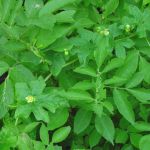| Common Name: |
English Mandrake |
| Other Names: |
White bryony, red bryony |
| Botanical Name: |
Bryonia dioica |
| Genus: |
Bryonia |
| Family: |
Cucurbitaceae |
| Native Location: |
Europe, except Scandinavia |
| Cultivation: |
Well-drained neutral to alkaline soil in sun. |
| Propagation: |
By seed sown in autumn; by root cuttings or division of tuber in winter. |
| Harvest: |
Root is lifted in autumn, sliced, and dried for liquid extracts. |
| Height: |
4m (12ft) |
| Hardiness: |
Z4-9 |
| Parts Used: |
Roots |
| Properties: |
A bitter, purgative herb that irritates the tissues, increasing blood supply to the area. It is known to have anti-tumor, anti-rheumatic, and anti-viral effects. |
| Medicinal Uses: |
Formerly used internally in small doses for bronchial complaints, asthma, intestinal ulcers, hypertension, and arthritis. Externally, as a rubefacient, in muscular and joint pains, and pleurisy. For use by qualified practitioners only. Not prescribed during pregnancy. Highly toxic in large doses. |
| Warning: |
All parts are poisonous. Fresh root is a severe skin irritant. |
| Bibliography: |
Encylopedia of Herbs by Deni Brown Copyright ©: 1995, 2001 Dorling Kindersley Limited pp 147-148
|

